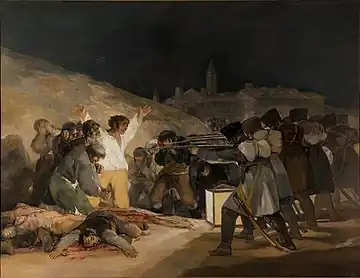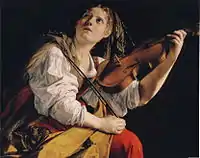Night in paintings (Western art)
The depiction of night in paintings is common in Western art. Paintings that feature a night scene as the theme may be religious or history paintings, genre scenes, portraits, landscapes, or other subject types. Some artworks involve religious or fantasy topics using the quality of dim night light to create mysterious atmospheres. The source of illumination in a night scene—whether it is the moon or an artificial light source—may be depicted directly, or it may be implied by the character and coloration of the light that reflects from the subjects depicted.
Historical overview
Beginning in the early Renaissance, artists such as Giotto, Bosch, Uccello and others told stories with their painted works, sometimes evoking religious themes and sometimes depicting battles, myths, stories and scenes from history, using night-time as the setting. By the 16th and 17th centuries, painters of the late Renaissance, Mannerists, and painters from the Baroque era including El Greco, Titian, Giorgione, Caravaggio, Frans Hals, Rembrandt, Velázquez, Jusepe de Ribera often portrayed people and scenes in night-time settings, illustrating stories and depictions of real life.
Eighteenth-century Rococo painters Antoine Watteau, François Boucher, Jean-Honoré Fragonard, and others used the night-time theme to illustrate scenes of the imagination, often with dramatic literary connotations, including scenes of secret liaisons and romantic relationships reminiscent of the popular 1782 book Les Liaisons dangereuses by Pierre Choderlos de Laclos. Jean-Baptiste-Siméon Chardin, Jean-Baptiste Greuze, used the themes of nighttime to depict illustrations of ordinary life. Poet and painter William Blake and painter Henry Fuseli used the night-time in their work as the setting for many of their most imaginative visions. The most dramatic use of the night-time can be seen in the 1793 painting by Jacques-Louis David, called The Death of Marat, portraying the French revolutionary leader Jean-Paul Marat after his murder by Charlotte Corday.
The night in paintings of the 19th century was used to convey a complex of diverse meanings. A mystical, religious, and sublime reverence for nature is seen in Caspar David Friedrich, Thomas Cole, Frederick Church, Albert Bierstadt, Albert Pinkham Ryder and others, while the powerful and dramatic romanticism of Francisco Goya, Théodore Géricault, and Eugène Delacroix served as visual reportage of current events, and in the case of Géricault revealed a scandal. Gustave Courbet, who with Honoré Daumier, Jules Breton, Jean-François Millet, and others created the Realist school, portrayed ordinary people hard at work, traveling, or engrossed in their everyday lives, at night and during the day. The Impressionists and Post-Impressionists of the late 19th century used the night-time theme to express a multitude of emotional and aesthetic insights seen most dramatically in the paintings of Edgar Degas, Paul Cézanne, Vincent van Gogh and others.
Symbolism

Black and grey shades often symbolize gloom, fear, mystery, superstitions, evil, death, secret, sorrow. The light source in most religious paintings symbolize hope, guidance or divinity.
In fantasy paintings light could symbolize magic, like the following lines of a poem entitled The Magic: "There's magic in this night, enshrouded in this night, hidden, like a lamp in an old man's robe, there's MAGIC."[1]: 61
History
14th century
 Pietro Lorenzetti, c. 1320, Stigmata of St Francis, Basilica of San Francesco d'Assisi
Pietro Lorenzetti, c. 1320, Stigmata of St Francis, Basilica of San Francesco d'Assisi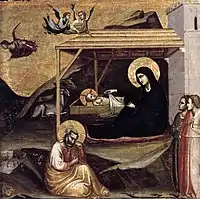 Taddeo Gaddi, Nativity, circa 1325, Fundación Colección Thyssen-Bornemisza, Pedralbes[2]
Taddeo Gaddi, Nativity, circa 1325, Fundación Colección Thyssen-Bornemisza, Pedralbes[2]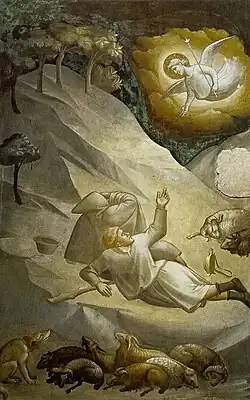 Taddeo Gaddi, The Angelic Announcement to the Shepherds, Fresco in the Basilica of Santa Croce, Florence, 1332–1338.[3]: 91
Taddeo Gaddi, The Angelic Announcement to the Shepherds, Fresco in the Basilica of Santa Croce, Florence, 1332–1338.[3]: 91
Gaddi, The Angelic Announcement to the Shepherds
One of the first attempts in depicting night in paintings was by Taddeo Gaddi, an Italian painter and architect.[4]: 67 Gaddi, fascinated by nocturnal lighting, depicted the effect of the light in The Angelic Announcement to the Shepherds night scene. The fresco at Basilica of Santa Croce in Florence, Italy features an incandescent angel as it hovers over a shepherd.[3]: 91 Against the night sky the brilliance of the angel's bright glow, likely intended as "verification of the presence of God and as a metaphor for spiritual enlightenment", appears to startle the shepherd. Gaddi's use of monochromatic colors in and around the shepherd reveals how the colors are made pale due to the remarkable illumination.[5]: 177, 179 [nb 1]
Giotto, Crucifixion
Giotto di Bondone (1266/7–1337), Taddeo Gaddi's teacher and godfather,[4]: 67 [nb 2] created the fresco of Crucifixion, one of the multiple frescoes that told the story of Christ's life, for the Arena Chapel. He depicts Christ on a cross, while the Virgin Mary is comforted by John. Kneeling at his feet is Mary Magdalene, and swirling in the sky above Jesus and the watching crowd's heads are a number of angels. Giotto depicts night and heaven through the use of a deep blue background in the fresco panel and use of stars in the otherwise blue ceiling.[6]: 383 [7] He was able to create depth and dimension through the use of incremental degrees of light and dark shades, the precursor to chiaroscuro. He also used light in a way to represent the divinity of people and angels from the Bible, as he did in other frescoes at Arena Chapel.[6]: 383
15th century
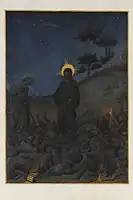 Très Riches Heures du Duc de Berry, Christ in Gethsemane, c. 1411–1416
Très Riches Heures du Duc de Berry, Christ in Gethsemane, c. 1411–1416 Geertgen tot Sint Jans, Nativity at Night c. 1490
Geertgen tot Sint Jans, Nativity at Night c. 1490 Master of the Houghton Miniatures, Annunciation to the Shepherds, (Flemish miniature ) c. late 15th century, J. Paul Getty Museum
Master of the Houghton Miniatures, Annunciation to the Shepherds, (Flemish miniature ) c. late 15th century, J. Paul Getty Museum
The Western tradition began properly in the 15th century, especially with depictions in illuminated manuscripts of the biblical night-time scenes of the Annunciation to the Shepherds in the Nativity story, and the Arrest of Christ and Agony in the Garden in the Passion of Christ.
Très Riches Heures, Christ in Gethsemane
In the book of miniatures, Très Riches Heures du Duc de Berry, the scene of Christ in Gethsemane is an apcolyptic one which foretells the death of Christ, through the presence of three comets in the evening sky.[8]
Uccello, Niccolò Mauruzi da Tolentino at the Battle of San Romano
_01.jpg.webp) Paolo Uccello, Niccolò Mauruzi da Tolentino at the Battle of San Romano, left panel. National Gallery, London
Paolo Uccello, Niccolò Mauruzi da Tolentino at the Battle of San Romano, left panel. National Gallery, London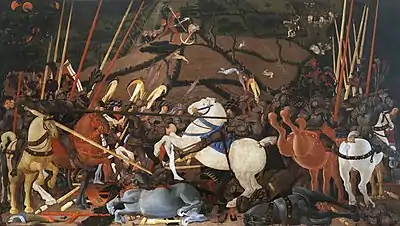 Paolo Uccello, Niccolò Mauruzi da Tolentino unseats Bernardino della Ciarda at the Battle of San Romano, center panel. Galleria degli Uffizi, Florence
Paolo Uccello, Niccolò Mauruzi da Tolentino unseats Bernardino della Ciarda at the Battle of San Romano, center panel. Galleria degli Uffizi, Florence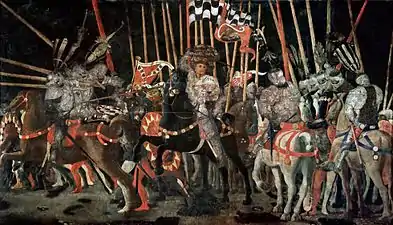 Paolo Uccello, The Counterattack of Michelotto da Cotignola at the Battle of San Romano, right panel. Musée du Louvre, Paris
Paolo Uccello, The Counterattack of Michelotto da Cotignola at the Battle of San Romano, right panel. Musée du Louvre, Paris
Niccolò Mauruzi da Tolentino at the Battle of San Romano is one of a three painting series that captures the Battle of San Romano.[9] The passage of time, from dawn to evening, is illustrated in the three paintings with the initial use of pale, pastel shades and increasingly darker tones as the battle progresses.[10]: 84, 90
Geertgen, Nativity at Night
Influenced by a vision of Saint Bridget of Sweden (1303–1373), Geertgen tot Sint Jans's Nativity at Night depicts the infant Jesus who "radiated such an ineffable light and splendour, that the sun was not comparable to it, nor did the candle that St. Joseph had put there, give any light at all, the divine light totally annihilating the material light of the candle."[11]: 78 Strengthening the message about the baby Jesus being the light source, Geertgen depicts the child as the only source of illumination for the main scene inside the stable. Aglow are the faces of the angels, St Joseph and Virgin Mary. Although the shepherds' fire on the hill behind and the angel outside the window create a light source, it's dim in comparison to that provided by the infant child. The sharp contrast of the divine light against dark is a tool used to make the scene appear more profound for its viewers.[12]: 232 [13] London's National Gallery describes Geertgen's work as: "one of the most engaging and convincing early treatments of the Nativity as a night scene.[13]
Annunciation to the Shepherds
In the still of the night, the only source of light radiates in Annunciation to the Shepherds comes from an angel who has come to tell the shepherds of the birth of the infant Christ. The light is so brilliant that the Bethlehem shepherds must shield their eyes. Aside from the startling angel, the nocturnal painting is a pleasant, still pastoral scene with a group of angels in the distance.[14]
16th century
 Hieronymus Bosch, The Garden of Earthly Delights, third panel, Hell, c. 1490–1510
Hieronymus Bosch, The Garden of Earthly Delights, third panel, Hell, c. 1490–1510 Albrecht Dürer, Way to Calvary, 1527
Albrecht Dürer, Way to Calvary, 1527 Dosso Dossi, The Holy Family, 1527–1528, Capitoline Museums, Rome
Dosso Dossi, The Holy Family, 1527–1528, Capitoline Museums, Rome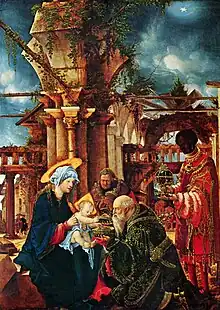 Albrecht Altdorfer, The Adoration of the Magi, c. 1530–1535, Städelsches Kunstinstitut, Frankfurt
Albrecht Altdorfer, The Adoration of the Magi, c. 1530–1535, Städelsches Kunstinstitut, Frankfurt Cristofano Allori, Judith with the Head of Holophernes, c. 1580, Palazzo Pitti, Florence
Cristofano Allori, Judith with the Head of Holophernes, c. 1580, Palazzo Pitti, Florence Giuseppe Cesari, Christ Taken Prisoner, c. 1597
Giuseppe Cesari, Christ Taken Prisoner, c. 1597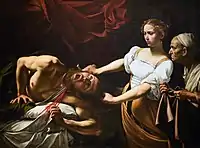 Michelangelo Merisi da Caravaggio, Judith Beheading Holofernes, c. 1598–1599, Galleria Nazionale d'Arte Antica, Rome
Michelangelo Merisi da Caravaggio, Judith Beheading Holofernes, c. 1598–1599, Galleria Nazionale d'Arte Antica, Rome
Dosso Dossi
Dosso Dossi (c. 1490 – 1542)[nb 3], was an Italian Renaissance painter who belonged to the Ferrara School of Painting.[4]: 56
Albrecht Altdorfer
Albrecht Altdorfer (c. 1480 – 12 February 1538) was a German painter, engraver and architect of the Renaissance of the so-called Danube School setting biblical and historical subjects against landscape backgrounds of expressive colours.[15]
Giuseppe Cesari
Giuseppe Cesari (c. 1568 – 3 July 1640) was an Italian Mannerist painter and instructor to Caravaggio.
17th century
 Michelangelo Merisi da Caravaggio, Supper at Emmaus, 1601, National Gallery, London
Michelangelo Merisi da Caravaggio, Supper at Emmaus, 1601, National Gallery, London.jpg.webp) Michelangelo Merisi da Caravaggio, The Taking of Christ, c. 1602, National Gallery of Ireland, Dublin
Michelangelo Merisi da Caravaggio, The Taking of Christ, c. 1602, National Gallery of Ireland, Dublin_2.jpg.webp) Adam Elsheimer, The Flight into Egypt c. 1609
Adam Elsheimer, The Flight into Egypt c. 1609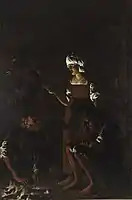 Hendrick ter Brugghen, The Denial of Saint Peter, c. 1607–1613
Hendrick ter Brugghen, The Denial of Saint Peter, c. 1607–1613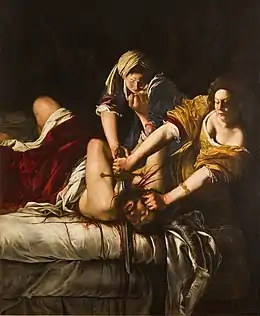 Artemisia Gentileschi, Judith Beheading Holofernes, 1614–1620, Galleria degli Uffizi, Florence
Artemisia Gentileschi, Judith Beheading Holofernes, 1614–1620, Galleria degli Uffizi, Florence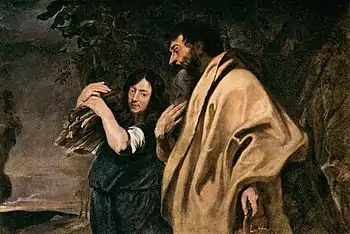 Anthony van Dyck, Abraham and Isaac, c. 1617, National Gallery, Prague
Anthony van Dyck, Abraham and Isaac, c. 1617, National Gallery, Prague Rembrandt, The Storm on the Sea of Galilee, 1633. The painting is still missing after robbery from the Isabella Stewart Gardner Museum in 1990.
Rembrandt, The Storm on the Sea of Galilee, 1633. The painting is still missing after robbery from the Isabella Stewart Gardner Museum in 1990.
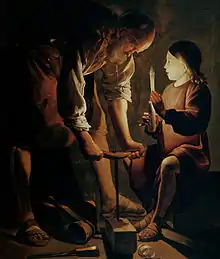
 Aert van der Neer, Moonlit Landscape with Bridge, 1648–1650, National Gallery of Art, Washington D.C.
Aert van der Neer, Moonlit Landscape with Bridge, 1648–1650, National Gallery of Art, Washington D.C.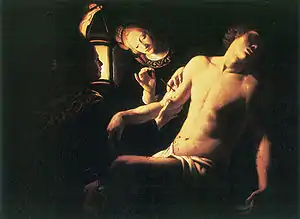 Trophime Bigot, St. Sebastian Aided by St. Irene, before 1650
Trophime Bigot, St. Sebastian Aided by St. Irene, before 1650 Cornelis Saftleven, A Witches' Sabbath, c. 1650, Chicago Art Institute
Cornelis Saftleven, A Witches' Sabbath, c. 1650, Chicago Art Institute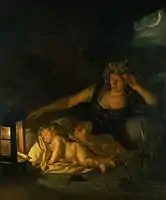 Joachim von Sandrart, Allegory of Night, 1654–1656
Joachim von Sandrart, Allegory of Night, 1654–1656 Godfried Schalcken, A Man Offering a Gold Chain and Coins to a Girl Seated on a Bed, c. 1665–1670
Godfried Schalcken, A Man Offering a Gold Chain and Coins to a Girl Seated on a Bed, c. 1665–1670
Adam Elsheimer
Early Baroque artist Adam Elsheimer created night scenes that were highly original. His works departed slightly from other works of the Baroque period were dramatic and abundantly detailed.[16] Baroque paintings featured "exaggerated lighting, intense emotions, release from restraint, and even a kind of artistic sensationalism".[17] Elsheimer's lighting effects in general were very subtle, and very different from those of Caravaggio. He often uses as many as five different sources of light, and graduates the light relatively gently, with the less well-lit parts of the composition often containing important parts of it.
Michelangelo Merisi da Caravaggio
Michelangelo Merisi da Caravaggio was an Italian artist active between 1593 and 1610. His paintings, which combine a realistic observation of the human state, both physical and emotional, with a dramatic use of lighting, had a formative influence on the Baroque school of painting.[6]: 298–299 [18] Caravaggio's novelty was a radical naturalism that combined close physical observation with a dramatic, even theatrical, use of chiaroscuro. This came to be known as Tenebrism, the shift from light to dark with little intermediate value.[6]: 299 [19]
Georges de La Tour
Georges de La Tour was a French Baroque painter who painted mostly religious chiaroscuro scenes lit by candlelight, which were more developed than his artistic predecessors, yet lacked dramatic effects of Caravaggio. He created some of the most arresting works in this genre, portraying a wide range of scenes by candlelight from card games to New Testament narratives.[20]
Aert van der Neer
The Dutch Golden Age painter Aert van der Neer was a landscape painter, specializing in small night scenes lit only by moonlight and fires, and snowy winter landscapes, both often looking down a canal or river.
Anthony van Dyck
Anthony van Dyck (22 March 1599 – 9 December 1641) was a Flemish Baroque artist and leading court painter in England.
18th century
 William Hogarth, Marriage A-la-Mode: 5, The Bagnio, c. 1743
William Hogarth, Marriage A-la-Mode: 5, The Bagnio, c. 1743
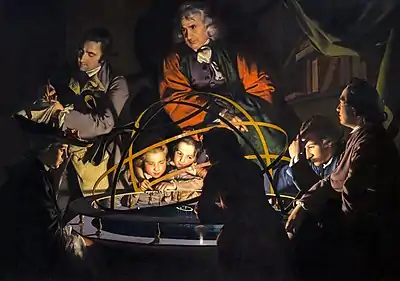

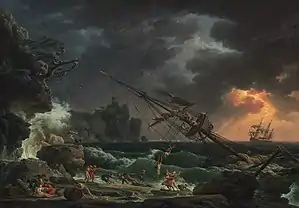
 Joseph Vernet, Night: Seaport by Moonlight, 1771, Louvre
Joseph Vernet, Night: Seaport by Moonlight, 1771, Louvre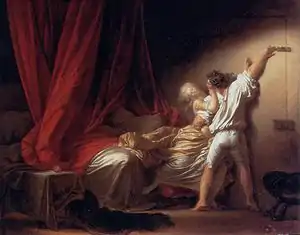 Jean-Honoré Fragonard, The Lock, 1776–1779, Louvre
Jean-Honoré Fragonard, The Lock, 1776–1779, Louvre.jpg.webp)
%252C_The_Nightmare%252C_1781.jpg.webp) Henry Fuseli, 1781, The Nightmare, a classical artist whose themes often anticipate the Romantic
Henry Fuseli, 1781, The Nightmare, a classical artist whose themes often anticipate the Romantic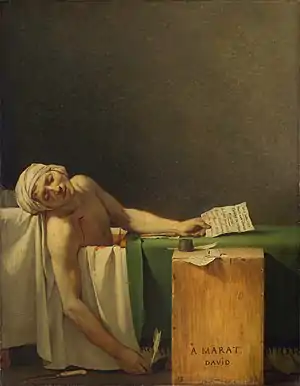
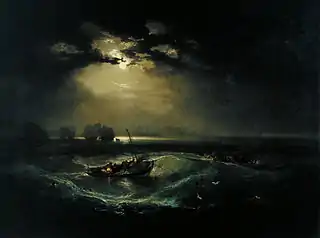 J. M. W. Turner, Fishermen at Sea, 1796
J. M. W. Turner, Fishermen at Sea, 1796
Joseph Turner
Joseph Mallord William Turner (23 April 1775 – 19 December 1851) was an English Romantic landscape painter,[21] who is commonly known as "the painter of light".[22]
Joseph Vernet
Claude-Joseph Vernet (14 August 1714 – 3 December 1789) was a French painter whose landscapes, including those of moonlights were popular with English aristocrats. His The Port of Rochefort (1763, Musée national de la Marine) is particularly notable; in the piece Vernet is able to achieve, according to art historian Michael Levey, one of his most 'crystalline and atmospherically sensitive skies'.[23]
Joseph Wright
Joseph Wright of Derby (3 September 1734 – 29 August 1797) was an English landscape and portrait painter who is notable for his use of Chiaroscuro effect, which emphasises the contrast of light and dark, and for his paintings of candle-lit subjects. Wright is seen at his best in his candlelit subjects. The Three Gentlemen observing the 'Gladiator' (1765). A Philosopher Lecturing on the Orrery shows an early mechanism for demonstrating the movement of the planets around the sun. An Experiment on a Bird in the Air Pump (1768) shows people gathered round observing an early experiment into the nature of air and its ability to support life.
These factual paintings are considered to have metaphorical meaning too, the bursting into light of the phosphorus in front of a praying figure signifying the problematic transition from faith to scientific understanding and enlightenment, and the various expressions on the figures around the bird in the air pump indicating concern over the possible inhumanity of the coming age of science.[24]
19th century
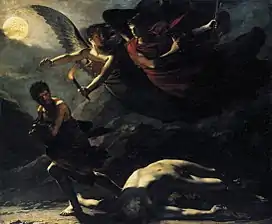 Pierre-Paul Prud'hon, Justice and Divine Vengeance Pursuing Crime, 1808, J. Paul Getty Museum, Getty Center, Los Angeles
Pierre-Paul Prud'hon, Justice and Divine Vengeance Pursuing Crime, 1808, J. Paul Getty Museum, Getty Center, Los Angeles Francisco Goya, The Festival of San Isidro, 1819–1823, Museo del Prado, Madrid
Francisco Goya, The Festival of San Isidro, 1819–1823, Museo del Prado, Madrid.jpg.webp) Henry Pether, Bacino di San Marco and Palazzo Ducale, Venice
Henry Pether, Bacino di San Marco and Palazzo Ducale, Venice.jpg.webp) Théodore Géricault, Study for Raft of the Medusa, c. 1818–1819, Louvre
Théodore Géricault, Study for Raft of the Medusa, c. 1818–1819, Louvre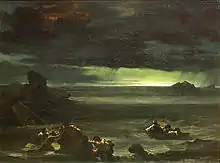 Théodore Géricault, After the Deluge, 1819
Théodore Géricault, After the Deluge, 1819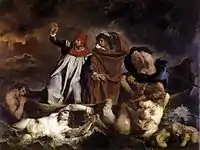 Eugène Delacroix, The Barque of Dante, 1822, Louvre
Eugène Delacroix, The Barque of Dante, 1822, Louvre.jpg.webp) Jules Breton, The Close of Day, 1865
Jules Breton, The Close of Day, 1865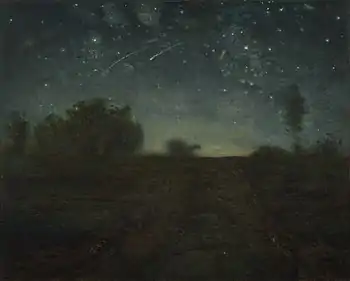 Jean-François Millet, Starry Night (Millet), c. 1850-1865
Jean-François Millet, Starry Night (Millet), c. 1850-1865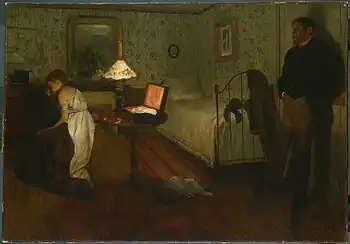 Edgar Degas, Interior (nicknamed The Rape) 1868–1869, Philadelphia Museum of Art
Edgar Degas, Interior (nicknamed The Rape) 1868–1869, Philadelphia Museum of Art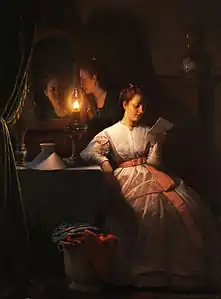 Petrus van Schendel, Der Liebesbrief, by 1870
Petrus van Schendel, Der Liebesbrief, by 1870 Jean-François Millet, Hunting Birds at Night, 1874
Jean-François Millet, Hunting Birds at Night, 1874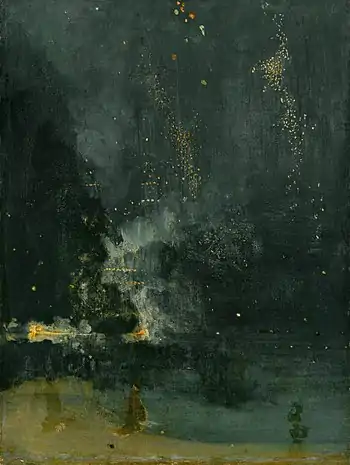
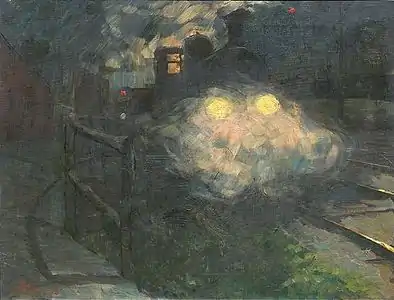 Evaporating locomotive at night, 1896 by Hermann Pleuer (1863–1911)
Evaporating locomotive at night, 1896 by Hermann Pleuer (1863–1911)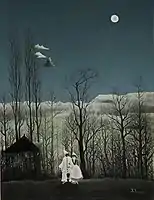
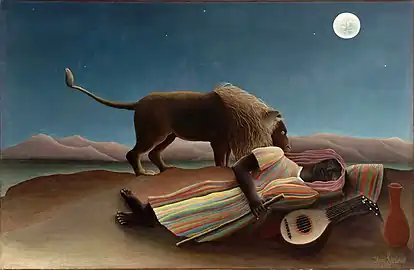 Henri Rousseau, La Bohémienne endormie (The Sleeping Gypsy – Zingara che dorme), 1897, Museum of Modern Art
Henri Rousseau, La Bohémienne endormie (The Sleeping Gypsy – Zingara che dorme), 1897, Museum of Modern Art_Caf%C3%A9terras_bij_nacht_(place_du_Forum)_Kr%C3%B6ller-M%C3%BCller_Museum_Otterlo_23-8-2016_13-35-40.JPG.webp) Vincent van Gogh, Café Terrace at Night, September 1888, Kröller-Müller Museum, Otterlo, The Netherlands
Vincent van Gogh, Café Terrace at Night, September 1888, Kröller-Müller Museum, Otterlo, The Netherlands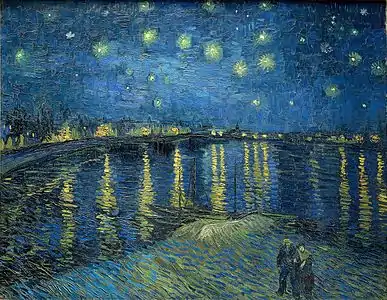
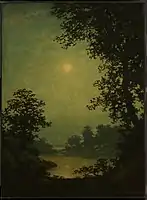 Ralph Albert Blakelock, Moonlight Sonata, 1889–1892, Museum of Fine Arts, Boston
Ralph Albert Blakelock, Moonlight Sonata, 1889–1892, Museum of Fine Arts, Boston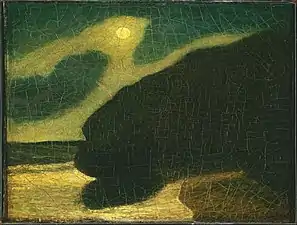 Albert Pinkham Ryder, Seacoast in Moonlight, 1890, the Phillips Collection, Washington, D.C.
Albert Pinkham Ryder, Seacoast in Moonlight, 1890, the Phillips Collection, Washington, D.C.
Théodore Géricault
Théodore Géricault (26 September 1791 – 26 January 1824) was an influential French artist and one of the pioneers of the Romantic movement.
Atkinson Grimshaw
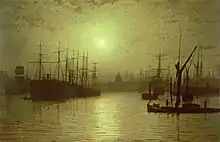
Atkinson Grimshaw (6 September 1836 – 13 October 1893) was a Victorian-era artist[25]: 173 known for his city night-scenes and landscapes.[26][27] His careful painting and skill in lighting effects meant that he captured both the appearance and the mood of a scene in minute detail. His "paintings of dampened gas-lit streets and misty waterfronts conveyed an eerie warmth as well as alienation in the urban scene."[28]: 99
On Hampstead Hill is considered one of Grimshaw's finest works, exemplifying his skill with a variety of light sources, in capturing the mood of the passing of twilight into night. In his later career his urban scenes under twilight or yellow streetlighting were popular with his middle-class patrons.[29]: 154
In the 1880s, Grimshaw maintained a London studio in Chelsea, not far from the studio of James Abbott McNeill Whistler. After visiting Grimshaw, Whistler remarked that "I considered myself the inventor of Nocturnes until I saw Grimmy's moonlit pictures."[30]: 112 Unlike Whistler's Impressionistic night scenes Grimshaw worked in a realistic vein: "sharply focused, almost photographic," his pictures innovated in applying the tradition of rural moonlight images to the Victorian city, recording "the rain and mist, the puddles and smoky fog of late Victorian industrial England with great poetry."[30]: 112–113
Petrus van Schendel
Petrus van Schendel (1806–1870) was a Dutch Romantic painter,[31] etcher and draughtsman. Van Schendel specialised in nocturnal Dutch market scenes, exploring the effects the soft light had upon his subjects, as a result he was named Monsieur Chandelle by the French. Van Schendel was inspired by these famous forebears, but brought a unique nineteenth century mood to his night scenes. He eloquently captured the mysterious world of city markets illuminated by lamps and moonlight before the dawn.
James Abbott McNeill Whistler
James Abbott McNeill Whistler (11 July 1834 – 17 July 1903) was an American-born, British-based artist.[32]: 50
Whistler's ill-advised journey in 1866 to Valparaíso, Chile,[32]: 141 resulted in Whistler's first three nocturnal paintings—which he termed "moonlights" and later re-titled as "nocturnes"—night scenes of the harbor painted with a blue or light green palette. Later in London, he painted several more nocturnes over the next ten years, many of the River Thames and of Cremorne Gardens, a pleasure park famous for its frequent fireworks displays, which presented a novel challenge to paint. In his maritime nocturnes, Whistler used highly thinned paint as a ground with lightly flicked color to suggest ships, lights, and shore line.[6]: 368 [33]: 30 Some of the Thames paintings also show compositional and thematic similarities with the Japanese prints of Hiroshige.[32]: 187
In 1877 Whistler sued the art critic John Ruskin for libel after the critic condemned his painting Nocturne in Black and Gold: The Falling Rocket. Ruskin accused Whistler of "asking two hundred guineas for throwing a pot of paint in the public's face."[34] Whistler won the suit, but was awarded one farthing for damages.[35] The cost of the case bankrupted him. It has been suggested John Ruskin had had CADASIL and the visual disturbances this condition caused him might have been a factor in his irritation at this particular painting.[36] Whistler published his account of the trial in the pamphlet Whistler v. Ruskin: Art and Art Critics, included in his later The Gentle Art of Making Enemies (1890).
20th century
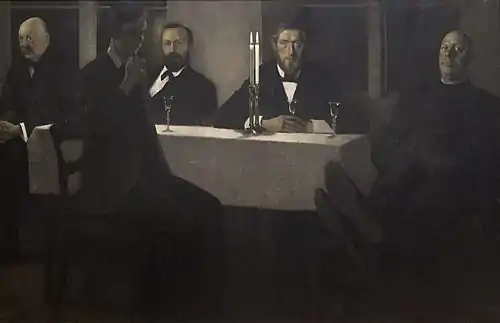 Vilhelm Hammershøi, Five Portraits, 1901–02
Vilhelm Hammershøi, Five Portraits, 1901–02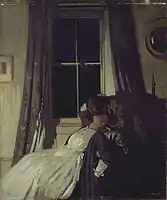 William Orpen, Night No. 2, 1907
William Orpen, Night No. 2, 1907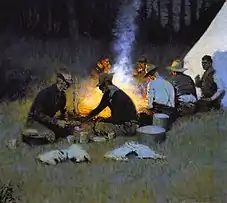 Frederic Remington, The Hunters' Supper, c. 1909, National Cowboy & Western Heritage Museum, Oklahoma City, Oklahoma
Frederic Remington, The Hunters' Supper, c. 1909, National Cowboy & Western Heritage Museum, Oklahoma City, Oklahoma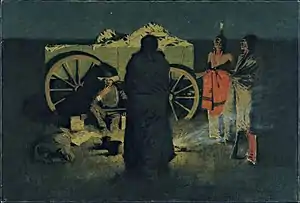 Frederic Remington, Shotgun Hospitality 1908, Hood Museum of Art, Dartmouth College, Hanover, New Hampshire
Frederic Remington, Shotgun Hospitality 1908, Hood Museum of Art, Dartmouth College, Hanover, New Hampshire.jpg.webp) George Bellows, Summer Night, Riverside Drive, 1909
George Bellows, Summer Night, Riverside Drive, 1909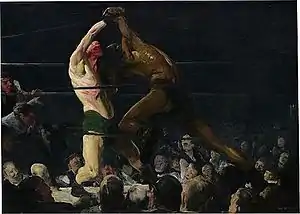 George Bellows, Both Members of This Club 1909, National Gallery of Art
George Bellows, Both Members of This Club 1909, National Gallery of Art Lovis Corinth, Rising Moon, 1922
Lovis Corinth, Rising Moon, 1922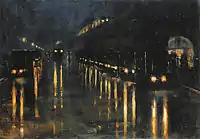 Lesser Ury, Hochbahnhof Bülowstraße, 1922
Lesser Ury, Hochbahnhof Bülowstraße, 1922
Famous examples
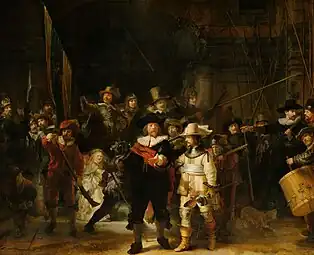
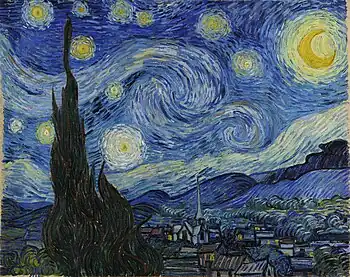

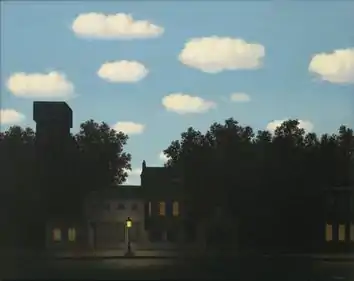
The Night Watch, Rembrandt van Rijn
The Night Watch or The Shooting Company of Frans Banning Cocq by Dutch painter Rembrandt van Rijn is one of the most famous paintings in the world. One of its key elements is the effective use of light and shadow (chiaroscuro).[37]: 61, 65 Made in 1642, it depicts the eponymous company moving out, led by Captain Frans Banning Cocq (dressed in black, with a red sash) and his lieutenant, Willem van Ruytenburch (dressed in yellow, with a white sash). With effective use of sunlight and shade, Rembrandt leads the eye to the three most important characters among the crowd, the two gentlemen in the centre (from whom the painting gets its original title), and the small girl in the centre left background.[37]: 65
For much of its existence, the painting was coated with a dark varnish which gave the incorrect impression that it depicted a night scene, leading to the name by which it is now commonly known. The heavy varnish was only discovered in the 1940s and restoration began after 1975.[38]: 224–225
The Third of May 1808, Francisco Goya
The Third of May 1808 by Spanish painter Francisco Goya commemorates Spanish resistance to Napoleon's armies during the occupation of 1808 in the Peninsular War.[39]: 109 The painting's content, presentation, and emotional force secure its status as a groundbreaking, archetypal image of the horrors of war. Although it draws on many sources from both high and popular art, The Third of May 1808 marks a clear break from convention. Diverging from the traditions of Christian art and traditional depictions of war, it has no distinct precedent, and is acknowledged as one of the first paintings of the modern era.[39]: 116–127 According to the art historian Kenneth Clark, The Third of May 1808 is "the first great picture which can be called revolutionary in every sense of the word, in style, in subject, and in intention".[40]: 130.
It is set in the early hours of the morning following the uprising[38]: 363 and centers on two masses of men: one a rigidly poised firing squad, the other a disorganized group of captives held at gun point. Executioners and victims face each other abruptly across a narrow space; according to Kenneth Clark, "by a stroke of genius [Goya] has contrasted the fierce repetition of the soldiers' attitudes and the steely line of their rifles, with the crumbling irregularity of their target."[40]: 127 A square lantern situated on the ground between the two groups throws a dramatic light on the scene. The brightest illumination falls on the huddled victims to the left, whose numbers include a monk or friar in prayer.[41]: 297 The central figure is the brilliantly lit man kneeling amid the bloodied corpses of those already executed, his arms flung wide in either appeal or defiance.[39]: 116
The painting is structurally and thematically tied to traditions of martyrdom in Christian art, as exemplified in the dramatic use of chiaroscuro, and the appeal to life juxtaposed with the inevitability of imminent execution.[39]: 121 However, Goya's painting departs from this tradition. Works that depicted violence, such as those by Jusepe de Ribera, feature an artful technique and harmonious composition which anticipate the "crown of martyrdom" for the victim.[39]: 118
The lantern as a source of illumination in art was widely used by Baroque artists, and perfected by Caravaggio.[39]: 119 Traditionally a dramatic light source and the resultant chiaroscuro were used as metaphors for the presence of God. Illumination by torch or candlelight took on religious connotations; but in The Third of May the lantern manifests no such miracle. Rather, it affords light only so that the firing squad may complete its grim work, and provides a stark illumination so that the viewer may bear witness to wanton violence. The traditional role of light in art as a conduit for the spiritual has been subverted.[39]: 119
The Starry Night, Vincent van Gogh
The Starry Night, made by Dutch artist Vincent van Gogh, depicts his memory of the view outside his sanitorium room window at Saint-Rémy-de-Provence (located in southern France) at night.[42]: 225 Although Van Gogh was not very happy with the painting,[43] art historian Joachim Pissarro cites The Starry Night as an exemplar of the artist's fascination with the nocturnal.[44] One of Van Gogh's most popular pieces, the painting is widely hailed as his magnum opus.[42]: 225
Nighthawks, Edward Hopper
Edward Hopper had a lifelong interest in capturing the effect of light on the objects it touched, including the nighttime effect of artificial, man-made light spilling out of windows, doorways and porches. Nighthawks was probably Hopper's most ambitious essay in capturing the night-time effects of man-made light. For one thing, the diner's plate-glass windows cause significant light to spill out onto the sidewalk and the brownstones on the far side of the street. As well, interior light comes from more than a single lightbulb, with the result that multiple shadows are cast, and some spots are brighter than others as a consequence of being lit from more than one angle. Across the street, the line of shadow caused by the upper edge of the diner window is clearly visible towards the top of the painting. These windows, and the ones below them as well, are partly lit by an unseen streetlight, which projects its own mix of light and shadow. As a final note, the bright interior light causes some of the surfaces within the diner to be reflective. This is clearest in the case of the right-hand edge of the rear window, which reflects a vertical yellow band of interior wall, but fainter reflections can also be made out, in the counter-top, of three of the diner's occupants. None of these reflections would be visible in daylight.
The Empire of Light, René Magritte
In his 1950 painting The Empire of Light, René Magritte (1898–1967),[45] explores the illusion of night and day, and the paradox of time and light. On the top half of his canvas Magritte paints a clear blue sky and white clouds that radiate bright daytime; while on the bottom half of his canvas below the sky, he paints a street, sidewalk, trees and houses all steeped in the darkness of night. The darkened trees and darkened houses appear to be in nighttime shadows, in the middle of the night; and the sidewalk streetlight is on to guide the way. Some of the questions implied by these pictures include is it night-time? is it daytime? or is it just a painting? The Empire of Light is one of a series of paintings that René Magritte painted between 1950 and 1954 that explores his surrealist insight into illusion and reality, using night and day as his subject.[46][45]
Gallery
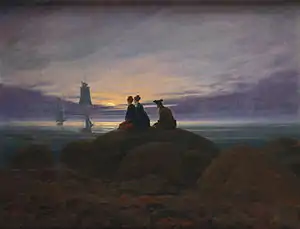
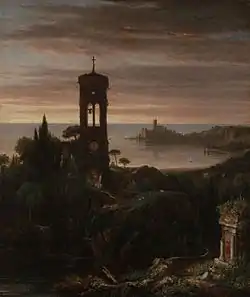 Thomas Cole, The Vesper Hymn, 1838
Thomas Cole, The Vesper Hymn, 1838.jpg.webp)
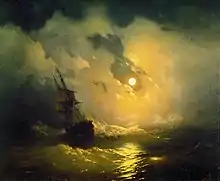 Ivan Aivazovsky, Stormy Sea in Night, 1849
Ivan Aivazovsky, Stormy Sea in Night, 1849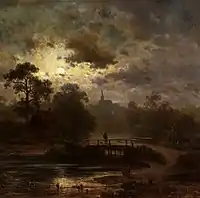 Jules Dupré, Landscape by moonlight, 1852
Jules Dupré, Landscape by moonlight, 1852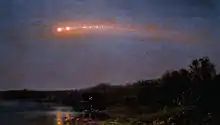
 Albert Bierstadt, Evening on the Prairie, c. 1870
Albert Bierstadt, Evening on the Prairie, c. 1870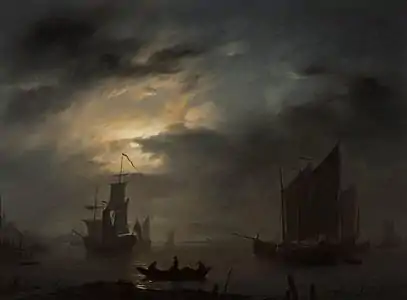 Petrus van Schendel, Nachtelijke marine, Unknown date, Collectie Rademakers
Petrus van Schendel, Nachtelijke marine, Unknown date, Collectie Rademakers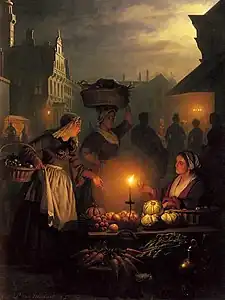 Petrus van Schendel, Market, Unknown date
Petrus van Schendel, Market, Unknown date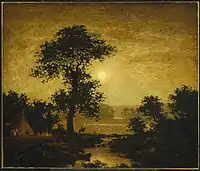 Ralph Albert Blakelock, Moonlight, 1885, Brooklyn Museum
Ralph Albert Blakelock, Moonlight, 1885, Brooklyn Museum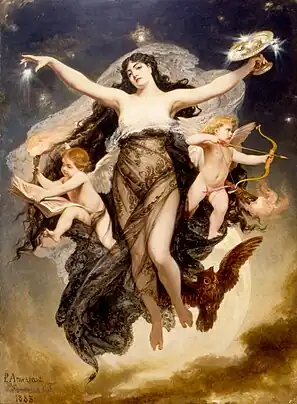 Pedro Américo, The Night Escorted by the Geniuses of Love and Study, 1886
Pedro Américo, The Night Escorted by the Geniuses of Love and Study, 1886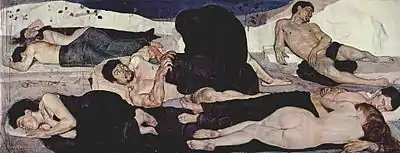 Ferdinand Hodler, The Night, 1889–1890
Ferdinand Hodler, The Night, 1889–1890
Notes
- A student and godson of Giotto di Bondone, Gaddi was influenced by Giotti's exploration away from traditional Medieval artistic works towards development of solid three-dimensional characters using contrasting dark and light shades to suggest depth and shape. The technique was a precursor to chiaroscuro.[4]: 67 [6]: 209 Gaddi may have sought to leverage this technique to its best advantage after having accepted the prominent commission for the church fresco early in his career to impress the public and his patrons.[5]: 177, 179 Thyssen-Bornemisza Museum[upper-alpha 1] notes that: "This ensemble [The Angelic Announcement to the Shepherds] is noted for its dynamism, pronounced foreshortening, dramatic effects of light and interest in narrative."[2] This is evidenced by the impact Gaddi's work had on successive church murals, such as the nearby Rinuccini Chapel's mural made about 40 years later.[5]: 177
- Giotto was an Italian painter in the late Middle Ages and generally considered a key contributor to the Italian Renaissance. In his day medieval paintings depicted flat, relatively unemotional people. Giotto, revolutionary for the 13th century, portrayed natural, three-dimensional people.[6][7]
- The 2003 Columbia Encyclopedia cites birthdate as c. 1479. The Getty Museum (which owns some of Dossi's works), Britannica, Encarta, and the monograph below cite birthdate as c. 1490.
- Thyssen-Bornemisza Museum has in its collection Taddeo Gaddi's Nativity which was made about 1325.
References
- Favorite, 1991.
- Taddeo Gaddi, Biography. Museo Thyssen-Bornemisza. Retrieved 26 August 2012.
- Paoletti and Radke, 2005.
- Farquhar, 1855.
- Norman, 1995.
- Gardner and Kleiner, 2009.
- "The Life of Christ: The Story of Christ: The noblest paintings of the Savior's life were done by Giotto for a chapel in Italy." Life Magazine, Time Inc., 27 December 1948. 25: 26. pp. 52, 53, 57. ISSN 0024-3019.
- Scheckner, p. 238.
- The Battle of San Romano. National Gallery, London. Retrieved 28 August 2012.
- Duffy, 1998.
- Schiller, including quotation.
- Campbell, 1998.
- The Nativity at Night. The National Gallery, London. Retrieved 27 August 2012.
- The Annunciation to the Shepherds. J. Paul Getty Museum. Retrieved 28 August 2012.
- Murray, Linda (1967). The High Renaissance and Mannerism. London, England: Thames & Hudson Ltd. pp. 246–247. ISBN 0-500-20162-5.
- Claude V. Palisca, "Baroque". The New Grove Dictionary of Music and Musicians, second edition, edited by Stanley Sadie and John Tyrrell (London: Macmillan Publishers, 2001).
- Hunt, Martin, Rosenwein, and Smith (2010). The Making of the West (third ed.). Boston: Bedford/ St. Martin's. pp. 469
- "ULAN Full Record Display (Getty Research)". www.getty.edu.
- Quoted in Gilles Lambert, "Caravaggio", p.8.
- Blunt.
- Lacayo, Richard, The Sunshine Boy, TIME Magazine, 11 October 2007.
- Turner, Joseph Mallord William Archived 25 May 2010 at the Wayback Machine National Gallery, London
- Levey.
- Baird, Olga; Malcolm Dick. "Joseph Wright of Derby: Art, the Enlightenment and Industrial Revolution". Archived from the original on 16 March 2007. Retrieved 23 November 2007.
- Wood, 1999.
- Robertson, 1996.
- H. J. Dyos, 1973.
- Waller, 1983.
- Steer.
- Lambourne, 1999.
- WG Flippo. (1981). Lexicon of the Belgian Romantic Painters, Antwerp.
- Anderson and Koval, 2002.
- Peters, 1998.
- From the Tate, retrieved 12 April 2009
- Whistler, James Abbott McNeill. WebMuseumn, Paris
- Kempster PA, Alty JE. (2008). John Ruskin's relapsing encephalopathy. Brain. Sep;131(Pt 9):2520-5. doi:10.1093/brain/awn019 PMID 18287121
- Boka and Courteau, 1994.
- Hagen and Hagen, 2003.
- Licht, 1979.
- Clark, 1968.
- Boime, 1990.
- Zara, 2012.
- Van Gogh, Vincent. (author). Harrison, Robert. (ed.) (19 September 1889) Letter to Theo van Gogh. Written in Saint-Rémy. Translated by Mrs. Johanna van Gogh-Bonger, number 607. Webexhibits.org Retrieved 24 August 2012.
- Vogel, Carol. (13 June 2008). Nytimes.com Darkness Was Muse for a Master of Light. The New York Times. Retrieved 24 August 2012.
- "The Collection | MoMA". The Museum of Modern Art.
- "Guggenheim Museum". Archived from the original on 14 September 2012. Retrieved 26 August 2012.
Sources
- Anderson, Ronald and Anne Koval. (2002). James McNeill Whistler: Beyond the Myth. Da Capo Press. ISBN 0-7867-1032-2. (Note: need to verify this was the edition used.)
- Boime, Albert. (1990). Art in an Age of Bonapartism, 1800–1815. The University of Chicago Press. ISBN 0-226-06335-6.
- Blunt, Anthony. (1999) [1953]. Art and Architecture in France, 1500–1700. Yale University Press. ISBN 0-300-07748-3.
- Boka, Georges and Bernard Courteau. (1994). Rembrandt's Nightwatch : The Mystery Revealed. Georges Boka Editeur. ISBN 2-920217-41-0.
- Campbell, Lorne, National Gallery Catalogues (new series). (1998). The Fifteenth Century Netherlandish Paintings. National Gallery Publications. ISBN 1-85709-171-X.
- Clark, Kenneth. (1968). Looking at Pictures. Beacon Press. ISBN 0-8070-6689-3. (found on Artchive)
- Duffy, Jean H. (1998). Reading Between the Lines: Claude Simon and the Visual Arts. Volume 2 of Modern French Writers. Liverpool University Press. ISBN 0-85323-851-0.
- Dyos, H. J. and Michael Wolff (eds.) (1999) [1973]. The Victorian City: Images and Realities, 2 Volumes. Psychology Press. ISBN 0-415-19323-0.
- Farquhar, Maria. (1855). Biographical catalog of the principal Italian painters: with a table of the contemporary schools of Italy. Designed as a hand-book to the picture gallery. J. Murray.
- Favorite, Malaika. (1991). Illuminated Manuscript: Poems and Prints. New Orleans Poetry Journal. Journal Press Books: Louisiana Legacy. ISBN 0-938498-09-6.
- Freedberg, Sydney J. (1971). Painting in Italy, 1500–1600, first edition. The Pelican History of Art. Harmondsworth and Baltimore: Penguin Books. ISBN 0-14-056035-1.
- Gardner, Helen and Fred S. Kleiner. (2009). Gardner's Art Through the Ages: A Concise Global History. (2nd edition). Cengage Learning. ISBN 0-495-50346-0.
- Hagen, Rose-Marie and Hagen, Rainer. (28 February 2003.) What Great Paintings Say. Taschen. ISBN 3-8228-2100-4
- Henderson, Andrea and Vincent Katz. (2008). Picturing New York: The Art of Yvonne Jacquette and Rudy Burckhardt. Museum of the City of New York, Contributor. Bunker Hill Publishing. ISBN 1-59373-065-9.
- Licht, Fred. (1979). Goya: The Origins of the Modern Temper in Art. Universe Books. ISBN 0-87663-294-0
- Lambourne, Lionel. (1999). Victorian Painting. London: Phaidon Press.
- Norman, Diana. (1995). Siena, Florence and Padua: Art, Society and Religion 1280–1400, Volume II. Yale University Press. ISBN 0-300-06127-7.
- Paoletti, John T. and Gary M. Radke. (2005). Art in Renaissance Italy, 3rd edition. Laurence King Publishing. ISBN 1-85669-439-9.
- Peters, Lisa N. (1998). James McNeil Whistler. Todtri. ISBN 1-880908-70-0.
- Robertson, Alexander. (1996). Atkinson Grimshaw. London: Phaidon Press. ISBN 0-7148-2525-5.
- Schechner, Sara. (1999). Comets, Popular Culture, and the Birth of Modern Cosmology. Princeton University Press. ISBN 0-691-00925-2.
- Schiller, Gertrud. (1971). Iconography of Christian Art, Vol. I. (English trans from German), Lund Humphries, London. ISBN 0-85331-270-2.
- Steer, Isabella. (2002). The History of British Art. Bath: Parragon. ISBN 0-7525-7602-X
- Waller, Philip J. (1983). Town, City, and Nation. Oxford: Oxford University Press.
- Wood, Christopher. (1999). Victorian Painting. Boston: Little, Brown & Co.
- Zara, Christopher. (2012). Tortured Artists: From Picasso and Monroe to Warhol and Winehouse, the Twisted Secrets of the World's Most Creative Minds. Adams Media. ISBN 1-4405-3003-3.
- Possible sources
- Jethani, S (2009). The Divine Commodity: Discovering a Faith Beyond Consumer Christianity. Grand Rapids, MI: Zondervan (eBook). ISBN 978-0-310-57422-4.
- Selz, Peter. (1974). German Expressionist Painting. University of California Press. ISBN 0-520-02515-6.
- Suckale, Robert and Manfred Wundram, Andreas Prater, Hermann Bauer, Eva-Gesine Baur. (2002). Masterpieces of Western Art: A History of Art in 900 Individual Studies from the Gothic to the Present Day. Taschen. ISBN 3-8228-1825-9.
- Taylor, William Edward and Harriet Garcia Warkel, Margaret Taylor Burroughs. (authors) Indianapolis Museum of Art. (ed.) (1996). A Shared Heritage: Art by Four African Americans. Undiana University Press. ISBN 0-936260-62-9.
- Van de Wetering, Ernst. (2002). Rembrandt: The Painter at Work. Rembrandt Series. Amsterdam University Press. ISBN 90-5356-239-7.
- Van Gogh, Vincent and Sjraar van Heugten, Joachim Pissarro, Chris Stolwijk. (2008). Van Gogh and the Colors of the Night The Museum of Modern Art. ISBN 0-87070-737-X.
Further reading
- Anderson, Nancy. (2003). Frederic Remington: The Color of Night. Princeton University Press. ISBN 0-691-11554-0.
- Denham, Robert D. (2010). Poets on Paintings: A Bibliography. McFarland. ISBN 0-7864-4725-7.
- Elkins, James (2004). Pictures & Tears: A History of People Who Have Cried in Front of Paintings. London: Routledge. ISBN 0-415-97053-9.
- Erickson, K (1998). At Eternity's Gate: The Spiritual Vision Of Vincent van Gogh. Grand Rapids, MI: William B. Eerdsmans Publishing. ISBN 0-8028-3856-1.
- Greenaway, Peter. (2006). Nightwatching: a view of Rembrandt's The Night Watch. Veenman. ISBN 90-8690-013-5.
- Katz, Alex and Donald Burton Kuspit. (1991). Night paintings. H.N. Abrams. ISBN 0-8109-3502-3.
- "The Life of Christ: The Story of Christ: The noblest paintings of the Saviour's life were done by Giotto for a chapel in Italy." Life Magazine, Time, Inc. 27 December 1948. 25: 26. p. 32–57. ISSN 0024-3019.
- MacDonald, Margaret F. (2001). Palaces in the Night: Whistler in Venice. University of California Press. ISBN 0-520-23049-3.
- Museum of Fine Arts, Boston; Hokusai Katsushika; Kojiro Tomita. (1957). Day and night in the four seasons. Volume 14 of Picture book series. Museum of Fine Arts.
- Nasgaard, Roald. (2007). Abstract Painting in Canada. Douglas & McIntyre. ISBN 1-55365-394-7.

